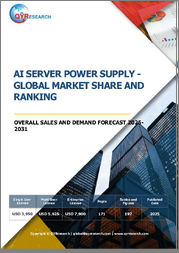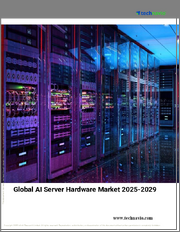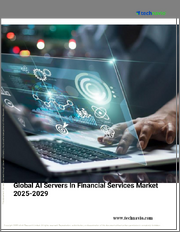
|
시장보고서
상품코드
1772285
AI 서버 시장 : 규모, 점유율, 동향 분석, 프로세서 유형별, 냉각 기술별, 폼 팩터별, 최종 용도별, 지역별, 부문 예측(2025-2030년)AI Server Market Size, Share, & Trends Analysis Report By Processor Type, By Cooling Technology, By Form Factor, By End Use, By Region, And Segment Forecasts, 2025 - 2030 |
||||||
AI 서버 시장 요약
세계의 AI 서버 시장 규모는 2024년에 1,248억 1,000만 달러로 평가되었고, 2025년부터 2030년에 걸쳐 CAGR 38.7%로 성장하여 2030년에는 8,541억 6,000만 달러에 달할 것으로 예측됩니다. 클라우드 컴퓨팅과 하이퍼스케일 데이터센터의 확대는 AI 서버 시장의 성장을 이끌고 있습니다.
주요 클라우드 서비스 제공업체는 AI-as-a-service 솔루션을 요구하는 기업 증가에 대응하기 위해 AI에 최적화된 서버 인프라에 많은 투자를 하고 있습니다. 이러한 도입에는 에너지 효율과 계산 처리량을 향상시킬 수 있는 커스텀 서버 아키텍처가 종종 포함됩니다. 또한 기업이 하이브리드 클라우드 및 멀티클라우드 전략으로 전환함에 따라 데이터센터 내에서 확장 가능하고 AI에 최적화된 서버 시스템에 대한 필요성이 더욱 커지고 중앙 집중식 교육과 에지 추론 시나리오를 모두 지원하는 것이 중요해지고 있습니다.
다양한 업계에서 생성형 AI 가 급속히 채택되고 있는 것이 AI 서버 시장의 성장을 뒷받침하고 있습니다. 대규모 병렬 처리와 빠른 데이터 처리량을 지원할 수 있는 고도로 특화된 서버 아키텍처가 필요합니다.
하이브리드 클라우드 및 멀티클라우드 전략의 시작은 AI 서버 구축을 가속화하고 있습니다. 이 제품은 다양한 환경 간의 부드러운 데이터 마이그레이션성과 통합된 AI 워크로드를 보장하기 위해 높은 적응성, 확장성 및 안전성을 요구합니다.
사이버 보안 및 데이터 프라이버시에 대한 우려는 On-Premise AI 서버의 필요성을 더욱 높여주고 있습니다. 이를 처리하는 것에 대한 저항감이 높아지고 있습니다. On-Premise의 AI 서버는 GDPR(EU 개인정보보호규정), HIPAA, PCI-DSS와 같은 엄격한 컴플라이언스 기준을 충족하기 위해 필요한 제어와 보안을 제공하고, 헬스케어, 금융, 방위 등 업계에 필수적입니다.
게다가 AI 칩셋과 시스템 온칩(SoC) 기술의 성장은 AI 서버의 설계와 기능을 변화시키고 있습니다. 설계는 처리 능력에 타협하지 않고 엣지 컴퓨팅 기능을 실현해, 모바일 유닛, 원격지, 재해 복구 사이트 등, 이전에는 실용적이지 않다고 생각되었던 환경에서의 AI 전개의 가능성을 엽니다.
목차
제1장 조사 방법과 범위
제2장 주요 요약
제3장 AI 서버 변수, 동향, 범위
- 시장 소개/계통 전망
- 업계 밸류체인 분석
- 시장 역학
- 시장 성장 촉진요인 분석
- 시장 성장 억제요인 분석
- 업계의 기회
- AI 서버 분석 도구
- Porter's Five Forces 분석
- PESTEL 분석
제4장 AI 서버 시장 : 프로세서 유형의 추정 및 예측 분석
- AI 서버 시장 : 프로세서 유형별 분석과 시장 점유율, 2024년과 2030년
- GPU 기반 서버
- FPGA 기반 서버
- ASIC 기반 서버
제5장 AI 서버 시장 : 냉각 기술의 추정 및 예측 분석
- AI 서버 시장 : 냉각 기술 분석과 시장 점유율별, 2024년과 2030년
- 공냉
- 액체 냉각
- 하이브리드 냉각
제6장 AI 서버 시장 : 폼 팩터 추정 및 예측 분석
- AI 서버 시장 : 폼 팩터 분석과 시장 점유율별, 2024년과 2030년
- 랙마운트형 서버
- 블레이드 서버
- 타워 서버
제7장 AI 서버 시장 : 최종 용도 추정 및 예측 분석
- AI 서버 시장 : 최종 용도 분석과 시장 점유율별, 2024년과 2030년
- IT 및 통신
- BFSI
- 소매 및 E커머스
- 헬스케어 및 의약품
- 자동차
- 기타
제8장 AI 서버 시장 : 지역의 추정 및 예측 분석
- AI 서버 시장 점유율(지역별, 2024년 및 2030년)
- 북미
- 프로세서 유형별, 2018년-2030년
- 냉각 기술별, 2018년-2030년
- 폼 팩터별, 2018년-2030년
- 최종 용도별, 2018년-2030년
- 미국
- 캐나다
- 멕시코
- 유럽
- 프로세서 유형별, 2018년-2030년
- 냉각 기술별, 2018년-2030년
- 폼 팩터별, 2018년-2030년
- 최종 용도별, 2018년-2030년
- 영국
- 독일
- 프랑스
- 아시아태평양
- 프로세서 유형별, 2018년-2030년
- 냉각 기술별, 2018년-2030년
- 폼 팩터별, 2018년-2030년
- 최종 용도별, 2018년-2030년
- 중국
- 인도
- 일본
- 호주
- 한국
- 라틴아메리카
- 프로세서 유형별, 2018년-2030년
- 냉각 기술별, 2018년-2030년
- 폼 팩터별, 2018년-2030년
- 최종 용도별, 2018년-2030년
- 브라질
- 중동 및 아프리카
- 프로세서 유형별, 2018년-2030년
- 냉각 기술별, 2018년-2030년
- 폼 팩터별, 2018년-2030년
- 최종 용도별, 2018년-2030년
- 아랍에미리트(UAE)
- 사우디아라비아
- 남아프리카
제9장 경쟁 구도
- 주요 시장 진출기업에 의한 최근의 동향과 영향 분석
- 기업 분류
- 기업의 시장 점유율 분석, 2024년
- 기업 히트맵 분석
- 전략 매핑
- 확대
- 합병과 인수
- 파트너십 및 협업
- 제품 발매
- 최근 동향
- 기업 프로파일
- Dell Inc.
- Cisco Systems, Inc.
- IBM Corporation
- HP Development Company, LP
- Huawei Technologies Co., Ltd.
- NVIDIA Corporation
- Fujitsu Limited
- ADLINK Technology Inc.
- Lenovo Group Limited
- Super Micro Computer, Inc.
AI Server Market Summary
The global AI server market size was estimated at USD 124.81 billion in 2024 and is projected to reach USD 854.16 billion by 2030, growing at a CAGR of 38.7% from 2025 to 2030. Cloud computing and hyperscale data center expansion are driving the AI servers market growth.
Major cloud service providers are investing heavily in AI-optimized server infrastructure to cater to the growing number of enterprises seeking AI-as-a-service solutions. These deployments often involve custom server architectures, which allow for better energy efficiency and computational throughput. Moreover, as organizations shift toward hybrid and multi-cloud strategies, the need for scalable, AI-optimized server systems within data centers becomes even more critical, supporting both centralized training and edge inferencing scenarios.
The rapid adoption of generative AI applications across various industries is driving AI server market growth. From content creation and customer service automation to personalized marketing and drug discovery, generative AI is pushing the boundaries of compute-intensive operations. These applications require highly specialized server architectures capable of supporting massive parallelism and fast data throughput. The surge in demand for generative models like GPT and DALL*E is compelling enterprises and cloud providers to invest heavily in AI servers that can manage such computational intensity with speed and reliability.
The rise of hybrid and multi-cloud strategies is also accelerating the deployment of AI servers. Enterprises are opting for flexible infrastructure models that allow seamless integration between on-premises systems and public cloud platforms. Artificial intelligence (AI) servers designed for hybrid deployments must be highly adaptable, scalable, and secure to ensure smooth data mobility and unified AI workloads across diverse environments. This flexibility is crucial for organizations looking to optimize cost efficiency, performance, and regulatory compliance when deploying AI solutions at scale.
Cybersecurity and data privacy concerns are further fueling the need for on-premises AI servers. As organizations become increasingly reliant on AI for handling sensitive information such as biometric data, financial records, and proprietary business intelligence, there is growing reluctance to process such data in public cloud environments. On-prem AI servers offer the control and security needed to meet strict compliance standards like GDPR, HIPAA, and PCI-DSS, making them indispensable for industries such as healthcare, finance, and defense.
Moreover, the growth of AI chipsets and system-on-chip (SoC) technologies is transforming the design and capabilities of AI servers. Innovations in AI-specific hardware are leading to more compact, energy-efficient servers that can deliver unprecedented levels of performance. These new designs enable edge computing capabilities without compromising on processing power, and they open up possibilities for AI deployment in environments previously deemed impractical, like mobile units, remote locations, or disaster recovery sites. The continuous advancement of AI hardware is thus a foundational driver pushing the server market forward.
Global AI Server Market Report Segmentation
This report forecasts revenue growth at global, regional, and country levels and provides an analysis of the latest industry trends in each of the sub-segments from 2018 to 2030. For this study, Grand View Research has segmented the global AI server market report based on processor type, cooling technology, form factor, end use, and region.
- Processor Type Outlook (Revenue, USD Billion, 2018 - 2030)
- GPU-based Servers
- FPGA-based Servers
- ASIC-based Servers
- Cooling Technology Outlook (Revenue, USD Billion, 2018 - 2030)
- Air Cooling
- Liquid Cooling
- Hybrid Cooling
- Form Factor Outlook (Revenue, USD Billion, 2018 - 2030)
- Rack-mounted Servers
- Blade Servers
- Tower Servers
- End Use Outlook (Revenue, USD Billion, 2018 - 2030)
- IT & Telecommunication
- BFSI
- Retail & E-commerce
- Healthcare & Pharmaceutical
- Automotive
- Others
- Regional Outlook (Revenue, USD Billion, 2018 - 2030)
- North America
- U.S.
- Canada
- Mexico
- Europe
- Germany
- UK
- France
- Asia Pacific
- China
- India
- Japan
- South Korea
- Australia
- Latin America
- Brazil
- Middle East & Africa
- UAE
- Saudi Arabia
- South Africa
Table of Contents
Chapter 1. Methodology and Scope
- 1.1. Market Segmentation and Scope
- 1.2. Market Definitions
- 1.3. Research Methodology
- 1.3.1. Information Procurement
- 1.3.2. Information or Data Analysis
- 1.3.3. Market Formulation & Data Visualization
- 1.3.4. Data Validation & Publishing
- 1.4. Research Scope and Assumptions
- 1.4.1. List of Data Sources
Chapter 2. Executive Summary
- 2.1. Market Outlook
- 2.2. Segment Outlook
- 2.3. Competitive Insights
Chapter 3. AI Server Variables, Trends, & Scope
- 3.1. Market Introduction/Lineage Outlook
- 3.2. Industry Value Chain Analysis
- 3.3. Market Dynamics
- 3.3.1. Market Drivers Analysis
- 3.3.2. Market Restraints Analysis
- 3.3.3. Industry Opportunities
- 3.4. AI Server Analysis Tools
- 3.4.1. Porter's Analysis
- 3.4.1.1. Bargaining power of the suppliers
- 3.4.1.2. Bargaining power of the buyers
- 3.4.1.3. Threats of substitution
- 3.4.1.4. Threats from new entrants
- 3.4.1.5. Competitive rivalry
- 3.4.2. PESTEL Analysis
- 3.4.2.1. Political landscape
- 3.4.2.2. Economic and Social landscape
- 3.4.2.3. Technological landscape
- 3.4.2.4. Environmental landscape
- 3.4.2.5. Legal landscape
- 3.4.1. Porter's Analysis
Chapter 4. AI Server: Processor Type Estimates & Trend Analysis
- 4.1. AI Server Market, By Processor Type Analysis & Market Share, 2024 & 2030
- 4.2. GPU-based Servers
- 4.2.1. GPU-based servers market estimates and forecasts, 2018 - 2030 (USD Billion)
- 4.3. FPGA-based Servers
- 4.3.1. FPGA-based servers market estimates and forecasts, 2018 - 2030 (USD Billion)
- 4.4. ASIC-based Servers
- 4.4.1. ASIC-based servers market estimates and forecasts, 2018 - 2030 (USD Billion)
Chapter 5. AI Server: Cooling Technology Estimates & Trend Analysis
- 5.1. AI Server Market, By Cooling Technology Analysis & Market Share, 2024 & 2030
- 5.2. Air Cooling
- 5.2.1. Air cooling market estimates and forecasts, 2018 - 2030 (USD Billion)
- 5.3. Liquid Cooling
- 5.3.1. Liquid cooling market estimates and forecasts, 2018 - 2030 (USD Billion)
- 5.4. Hybrid Cooling
- 5.4.1. Hybrid cooling market estimates and forecasts, 2018 - 2030 (USD Billion)
Chapter 6. AI Server: Form Factor Estimates & Trend Analysis
- 6.1. AI Server Market, By Form Factor Analysis & Market Share, 2024 & 2030
- 6.2. Rack-mounted Servers
- 6.2.1. Rack-mounted servers market estimates and forecasts, 2018 - 2030 (USD Billion)
- 6.3. Blade Servers
- 6.3.1. Blade servers market estimates and forecasts, 2018 - 2030 (USD Billion)
- 6.4. Tower Servers
- 6.4.1. Tower servers market estimates and forecasts, 2018 - 2030 (USD Billion)
Chapter 7. AI Server: End Use Estimates & Trend Analysis
- 7.1. AI Server Market, By End Use Analysis & Market Share, 2024 & 2030
- 7.2. IT & Telecommunication
- 7.2.1. IT & telecommunication market estimates and forecasts, 2018 - 2030 (USD Billion)
- 7.3. BFSI
- 7.3.1. BFSI market estimates and forecasts, 2018 - 2030 (USD Billion)
- 7.4. Retail & E-commerce
- 7.4.1. Retail & e-commerce market estimates and forecasts, 2018 - 2030 (USD Billion)
- 7.5. Healthcare & Pharmaceutical
- 7.5.1. Healthcare & pharmaceutical market estimates and forecasts, 2018 - 2030 (USD Billion)
- 7.6. Automotive
- 7.6.1. Automotive market estimates and forecasts, 2018 - 2030 (USD Billion)
- 7.7. Others
- 7.7.1. Others market estimates and forecasts, 2018 - 2030 (USD Billion)
Chapter 8. AI Server Market: Regional Estimates & Trend Analysis
- 8.1. AI Server Market Share, By Region, 2024 & 2030 (USD Billion)
- 8.2. North America
- 8.2.1. Market Estimates and Forecasts, 2018 - 2030 (USD Billion)
- 8.2.2. Market estimates and forecast by processor type, 2018 - 2030 (Revenue, USD Billion)
- 8.2.3. Market estimates and forecast by cooling technology, 2018 - 2030 (Revenue, USD Billion)
- 8.2.4. Market estimates and forecast by form factor, 2018 - 2030 (Revenue, USD Billion)
- 8.2.5. Market estimates and forecast by end use, 2018 - 2030 (Revenue, USD Billion)
- 8.2.6. U.S.
- 8.2.6.1. Market Estimates and Forecasts, 2018 - 2030 (USD Billion)
- 8.2.6.2. Market estimates and forecast by processor type, 2018 - 2030 (Revenue, USD Billion)
- 8.2.6.3. Market estimates and forecast by cooling technology, 2018 - 2030 (Revenue, USD Billion)
- 8.2.6.4. Market estimates and forecast by form factor, 2018 - 2030 (Revenue, USD Billion)
- 8.2.6.5. Market estimates and forecast by end use, 2018 - 2030 (Revenue, USD Billion)
- 8.2.7. Canada
- 8.2.7.1. Market Estimates and Forecasts, 2018 - 2030 (USD Billion)
- 8.2.7.3. Market estimates and forecast by cooling technology, 2018 - 2030 (Revenue, USD Billion)
- 8.2.7.4. Market estimates and forecast by form factor, 2018 - 2030 (Revenue, USD Billion)
- 8.2.7.5. Market estimates and forecast by end use, 2018 - 2030 (Revenue, USD Billion)
- 8.2.8. Mexico
- 8.2.8.1. Market Estimates and Forecasts, 2018 - 2030 (USD Billion)
- 8.2.8.2. Market estimates and forecast by processor type, 2018 - 2030 (Revenue, USD Billion)
- 8.2.8.3. Market estimates and forecast by cooling technology, 2018 - 2030 (Revenue, USD Billion)
- 8.2.8.4. Market estimates and forecast by form factor, 2018 - 2030 (Revenue, USD Billion)
- 8.2.8.5. Market estimates and forecast by end use, 2018 - 2030 (Revenue, USD Billion)
- 8.3. Europe
- 8.3.1. Market estimates and forecast by processor type, 2018 - 2030 (Revenue, USD Billion)
- 8.3.2. Market estimates and forecast by cooling technology, 2018 - 2030 (Revenue, USD Billion)
- 8.3.3. Market estimates and forecast by form factor, 2018 - 2030 (Revenue, USD Billion)
- 8.3.4. Market estimates and forecast by end use, 2018 - 2030 (Revenue, USD Billion)
- 8.3.5. UK
- 8.3.5.1. Market Estimates and Forecasts, 2018 - 2030 (USD Billion)
- 8.3.5.2. Market estimates and forecast by processor type, 2018 - 2030 (Revenue, USD Billion)
- 8.3.5.3. Market estimates and forecast by cooling technology, 2018 - 2030 (Revenue, USD Billion)
- 8.3.5.4. Market estimates and forecast by form factor, 2018 - 2030 (Revenue, USD Billion)
- 8.3.5.5. Market estimates and forecast by end use, 2018 - 2030 (Revenue, USD Billion)
- 8.3.6. Germany
- 8.3.6.1. Market Estimates and Forecasts, 2018 - 2030 (USD Billion)
- 8.3.6.2. Market estimates and forecast by processor type, 2018 - 2030 (Revenue, USD Billion)
- 8.3.6.3. Market estimates and forecast by cooling technology, 2018 - 2030 (Revenue, USD Billion)
- 8.3.6.4. Market estimates and forecast by form factor, 2018 - 2030 (Revenue, USD Billion)
- 8.3.6.5. Market estimates and forecast by end use, 2018 - 2030 (Revenue, USD Billion)
- 8.3.7. France
- 8.3.7.1. Market Estimates and Forecasts, 2018 - 2030 (USD Billion)
- 8.3.7.2. Market estimates and forecast by processor type, 2018 - 2030 (Revenue, USD Billion)
- 8.3.7.3. Market estimates and forecast by cooling technology, 2018 - 2030 (Revenue, USD Billion)
- 8.3.7.4. Market estimates and forecast by form factor, 2018 - 2030 (Revenue, USD Billion)
- 8.3.7.5. Market estimates and forecast by end use, 2018 - 2030 (Revenue, USD Billion)
- 8.4. Asia Pacific
- 8.4.1. Market Estimates and Forecasts, 2018 - 2030 (USD Billion)
- 8.4.2. Market estimates and forecast by processor type, 2018 - 2030 (Revenue, USD Billion)
- 8.4.3. Market estimates and forecast by cooling technology, 2018 - 2030 (Revenue, USD Billion)
- 8.4.4. Market estimates and forecast by form factor, 2018 - 2030 (Revenue, USD Billion)
- 8.4.5. Market estimates and forecast by end use, 2018 - 2030 (Revenue, USD Billion)
- 8.4.6. China
- 8.4.6.1. Market Estimates and Forecasts, 2018 - 2030 (USD Billion)
- 8.4.6.2. Market estimates and forecast by processor type, 2018 - 2030 (Revenue, USD Billion)
- 8.4.6.3. Market estimates and forecast by cooling technology, 2018 - 2030 (Revenue, USD Billion)
- 8.4.6.4. Market estimates and forecast by form factor, 2018 - 2030 (Revenue, USD Billion)
- 8.4.6.5. Market estimates and forecast by end use, 2018 - 2030 (Revenue, USD Billion)
- 8.4.7. India
- 8.4.7.1. Market Estimates and Forecasts, 2018 - 2030 (USD Billion)
- 8.4.7.2. Market estimates and forecast by processor type, 2018 - 2030 (Revenue, USD Billion)
- 8.4.7.3. Market estimates and forecast by cooling technology, 2018 - 2030 (Revenue, USD Billion)
- 8.4.7.4. Market estimates and forecast by form factor, 2018 - 2030 (Revenue, USD Billion)
- 8.4.7.5. Market estimates and forecast by end use, 2018 - 2030 (Revenue, USD Billion)
- 8.4.8. Japan
- 8.4.8.1. Market Estimates and Forecasts, 2018 - 2030 (USD Billion)
- 8.4.8.2. Market estimates and forecast by processor type, 2018 - 2030 (Revenue, USD Billion)
- 8.4.8.3. Market estimates and forecast by cooling technology, 2018 - 2030 (Revenue, USD Billion)
- 8.4.8.4. Market estimates and forecast by form factor, 2018 - 2030 (Revenue, USD Billion)
- 8.4.8.5. Market estimates and forecast by end use, 2018 - 2030 (Revenue, USD Billion)
- 8.4.9. Australia
- 8.4.9.1. Market Estimates and Forecasts, 2018 - 2030 (USD Billion)
- 8.4.9.2. Market estimates and forecast by processor type, 2018 - 2030 (Revenue, USD Billion)
- 8.4.9.3. Market estimates and forecast by cooling technology, 2018 - 2030 (Revenue, USD Billion)
- 8.4.9.4. Market estimates and forecast by form factor, 2018 - 2030 (Revenue, USD Billion)
- 8.4.9.5. Market estimates and forecast by end use, 2018 - 2030 (Revenue, USD Billion)
- 8.4.10. South Korea
- 8.4.10.1. Market Estimates and Forecasts, 2018 - 2030 (USD Billion)
- 8.4.10.2. Market estimates and forecast by processor type, 2018 - 2030 (Revenue, USD Billion)
- 8.4.10.3. Market estimates and forecast by cooling technology, 2018 - 2030 (Revenue, USD Billion)
- 8.4.10.4. Market estimates and forecast by form factor, 2018 - 2030 (Revenue, USD Billion)
- 8.4.10.5. Market estimates and forecast by end use, 2018 - 2030 (Revenue, USD Billion)
- 8.5. Latin America
- 8.5.1. Market Estimates and Forecasts, 2018 - 2030 (USD Billion)
- 8.5.2. Market estimates and forecast by processor type, 2018 - 2030 (Revenue, USD Billion)
- 8.5.3. Market estimates and forecast by cooling technology, 2018 - 2030 (Revenue, USD Billion)
- 8.5.4. Market estimates and forecast by form factor, 2018 - 2030 (Revenue, USD Billion)
- 8.5.5. Market estimates and forecast by end use, 2018 - 2030 (Revenue, USD Billion)
- 8.5.6. Brazil
- 8.5.6.1. Market Estimates and Forecasts, 2018 - 2030 (USD Billion)
- 8.5.6.2. Market estimates and forecast by processor type, 2018 - 2030 (Revenue, USD Billion)
- 8.5.6.3. Market estimates and forecast by cooling technology, 2018 - 2030 (Revenue, USD Billion)
- 8.5.6.4. Market estimates and forecast by form factor, 2018 - 2030 (Revenue, USD Billion)
- 8.5.6.5. Market estimates and forecast by end use, 2018 - 2030 (Revenue, USD Billion)
- 8.6. Middle East & Africa
- 8.6.1. Market Estimates and Forecasts, 2018 - 2030 (USD Billion)
- 8.6.2. Market estimates and forecast by processor type, 2018 - 2030 (Revenue, USD Billion)
- 8.6.3. Market estimates and forecast by cooling technology, 2018 - 2030 (Revenue, USD Billion)
- 8.6.4. Market estimates and forecast by form factor, 2018 - 2030 (Revenue, USD Billion)
- 8.6.5. Market estimates and forecast by end use, 2018 - 2030 (Revenue, USD Billion)
- 8.6.6. UAE
- 8.6.6.1. Market Estimates and Forecasts, 2018 - 2030 (USD Billion)
- 8.6.6.2. Market estimates and forecast by processor type, 2018 - 2030 (Revenue, USD Billion)
- 8.6.6.3. Market estimates and forecast by cooling technology, 2018 - 2030 (Revenue, USD Billion)
- 8.6.6.4. Market estimates and forecast by form factor, 2018 - 2030 (Revenue, USD Billion)
- 8.6.6.5. Market estimates and forecast by end use, 2018 - 2030 (Revenue, USD Billion)
- 8.6.7. Saudi Arabia
- 8.6.7.1. Market Estimates and Forecasts, 2018 - 2030 (USD Billion)
- 8.6.7.2. Market estimates and forecast by processor type, 2018 - 2030 (Revenue, USD Billion)
- 8.6.7.3. Market estimates and forecast by cooling technology, 2018 - 2030 (Revenue, USD Billion)
- 8.6.7.4. Market estimates and forecast by form factor, 2018 - 2030 (Revenue, USD Billion)
- 8.6.7.5. Market estimates and forecast by end use, 2018 - 2030 (Revenue, USD Billion)
- 8.6.8. South Africa
- 8.6.8.1. Market Estimates and Forecasts, 2018 - 2030 (USD Billion)
- 8.6.8.2. Market estimates and forecast by processor type, 2018 - 2030 (Revenue, USD Billion)
- 8.6.8.3. Market estimates and forecast by cooling technology, 2018 - 2030 (Revenue, USD Billion)
- 8.6.8.4. Market estimates and forecast by form factor, 2018 - 2030 (Revenue, USD Billion)
- 8.6.8.5. Market estimates and forecast by end use, 2018 - 2030 (Revenue, USD Billion)
Chapter 9. Competitive Landscape
- 9.1. Recent Developments & Impact Analysis by Key Market Participants
- 9.2. Company Categorization
- 9.3. Company Market Share Analysis, 2024
- 9.4. Company Heat Map Analysis
- 9.5. Strategy Mapping
- 9.5.1. Expansion
- 9.5.2. Mergers & Acquisition
- 9.5.3. Partnerships & Collaborations
- 9.5.4. Product Launches
- 9.5.5. Recent Developments
- 9.6. Company Profiles
- 9.6.1. Dell Inc.
- 9.6.1.1. Participant's Overview
- 9.6.1.2. Financial Performance
- 9.6.1.3. Product Benchmarking
- 9.6.1.4. Recent Developments
- 9.6.2. Cisco Systems, Inc.
- 9.6.2.1. Participant's Overview
- 9.6.2.2. Financial Performance
- 9.6.2.3. Product Benchmarking
- 9.6.2.4. Recent Developments
- 9.6.3. IBM Corporation
- 9.6.3.1. Participant's Overview
- 9.6.3.2. Financial Performance
- 9.6.3.3. Product Benchmarking
- 9.6.3.4. Recent Developments
- 9.6.4. HP Development Company, L.P.
- 9.6.4.1. Participant's Overview
- 9.6.4.2. Financial Performance
- 9.6.4.3. Product Benchmarking
- 9.6.4.4. Recent Developments
- 9.6.5. Huawei Technologies Co., Ltd.
- 9.6.5.1. Participant's Overview
- 9.6.5.2. Financial Performance
- 9.6.5.3. Product Benchmarking
- 9.6.5.4. Recent Developments
- 9.6.6. NVIDIA Corporation
- 9.6.6.1. Participant's Overview
- 9.6.6.2. Financial Performance
- 9.6.6.3. Product Benchmarking
- 9.6.6.4. Recent Developments
- 9.6.7. Fujitsu Limited
- 9.6.7.1. Participant's Overview
- 9.6.7.2. Financial Performance
- 9.6.7.3. Product Benchmarking
- 9.6.7.4. Recent Developments
- 9.6.8. ADLINK Technology Inc.
- 9.6.8.1. Participant's Overview
- 9.6.8.2. Financial Performance
- 9.6.8.3. Product Benchmarking
- 9.6.8.4. Recent Developments
- 9.6.9. Lenovo Group Limited
- 9.6.9.1. Participant's Overview
- 9.6.9.2. Financial Performance
- 9.6.9.3. Product Benchmarking
- 9.6.9.4. Recent Developments
- 9.6.10. Super Micro Computer, Inc.
- 9.6.10.1. Participant's Overview
- 9.6.10.2. Financial Performance
- 9.6.10.3. Product Benchmarking
- 9.6.10.4. Recent Developments
- 9.6.1. Dell Inc.
(주말 및 공휴일 제외)


















